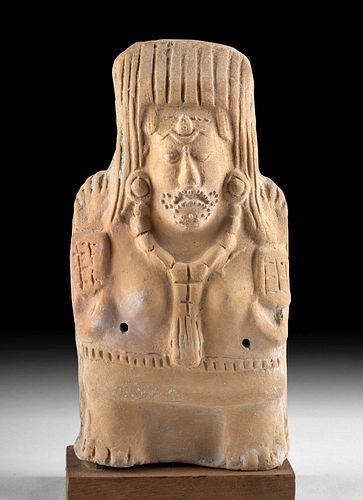Maya Jaina Pottery Rattle Figure with Scarified Mouth
Lot 74
About Seller
Artemis Fine Arts
686 S Taylor Ave, Ste 106
Louisville, CO 80027
United States
Selling antiquities, ancient and ethnographic art online since 1993, Artemis Gallery specializes in Classical Antiquities (Egyptian, Greek, Roman, Near Eastern), Asian, Pre-Columbian, African / Tribal / Oceanographic art. Our extensive inventory includes pottery, stone, metal, wood, glass and textil...Read more
Categories
Estimate:
$800 - $1,200
Absentee vs Live bid
Two ways to bid:
- Leave a max absentee bid and the platform will bid on your behalf up to your maximum bid during the live auction.
- Bid live during the auction and your bids will be submitted real-time to the auctioneer.
Bid Increments
| Price | Bid Increment |
|---|---|
| $0 | $25 |
| $300 | $50 |
| $1,000 | $100 |
| $2,000 | $250 |
| $5,000 | $500 |
| $10,000 | $1,000 |
| $20,000 | $2,500 |
| $50,000 | $5,000 |
| $100,000 | $10,000 |
| $200,000 | $20,000 |
About Auction
By Artemis Fine Arts
Jan 21, 2021
Set Reminder
2021-01-21 10:00:00
2021-01-21 10:00:00
America/New_York
Bidsquare
Bidsquare : Ancient / Ethnographic From Around The World
https://www.bidsquare.com/auctions/artemis-gallery/ancient-ethnographic-from-around-the-world-6316
Ancient art from Egypt, Greece, Italy and the Near East, as well as Asian, Pre-Columbian, Native American, African / Tribal / Oceanic, Spanish Colonial, Russian Icons, Fine art, much more! All categories, all price ranges... all legally acquired and guaranteed to be as described or your money back. Artemis Fine Arts info@artemisgallery.com
Ancient art from Egypt, Greece, Italy and the Near East, as well as Asian, Pre-Columbian, Native American, African / Tribal / Oceanic, Spanish Colonial, Russian Icons, Fine art, much more! All categories, all price ranges... all legally acquired and guaranteed to be as described or your money back. Artemis Fine Arts info@artemisgallery.com
- Lot Description
Pre-Columbian, Mexico, Jaina/Campeche, Maya, Late Classic Period, ca. 600 to 850 CE. A still-functioning terracotta figural rattle depicting a standing female, perhaps a priestess, with spotted scarring on the lower part of her face. Holding both hands up to her shoulders, the hollow figure wears a sizeable beaded necklace that hangs between her breasts, a tall feathered headdress, an undulating headband with an ovoid pendant, round earspools, a striped belt, and a netted pattern over her arms, perhaps to represent maize. Her finely rendered face presents a round nose, narrowed eyes, and a downturned mouth. Finally, the figure stands upon attenuated feet with incised toes. Size: 3.375" W x 6.5" H (8.6 cm x 16.5 cm)
These figures, from an island off the Yucatan peninsula, are noted for their lifelike faces and their immense detail. Scholars believe that they represented actual people and were probably created in Campeche and brought to Jaina Island to be buried with the deceased. This type of female figure represents a woman who is associated with the act of bloodletting sacrifice. Her mouth area shows cicatrice scarring (bead like forms). The mouth and tongue were the parts of the body where royal Maya females pierced themselves during ritual acts of bloodletting. These stocky, buxom female figures are considered common in the corpus of "Jaina" type figures, but, in fact, they are quite rarely found and are important examples to show the role of females in Maya bloodletting ritual.
Provenance: ex-old private New England collection, acquired in the 1970s; ex-private Houston, Texas, USA collection
All items legal to buy/sell under U.S. Statute covering cultural patrimony Code 2600, CHAPTER 14, and are guaranteed to be as described or your money back.
A Certificate of Authenticity will accompany all winning bids.
We ship worldwide and handle all shipping in-house for your convenience.
#161686Intact and still functional with numerous calcite deposits and manganese dioxide blooms throughout.Condition
- Shipping Info
-
All shipping is handled in-house for your convenience. Your invoice from Artemis Gallery will include shipping calculation instructions. If in doubt, please inquire BEFORE bidding for estimated shipping costs for individual items.
-
- Buyer's Premium



 EUR
EUR CAD
CAD AUD
AUD GBP
GBP MXN
MXN HKD
HKD CNY
CNY MYR
MYR SEK
SEK SGD
SGD CHF
CHF THB
THB














